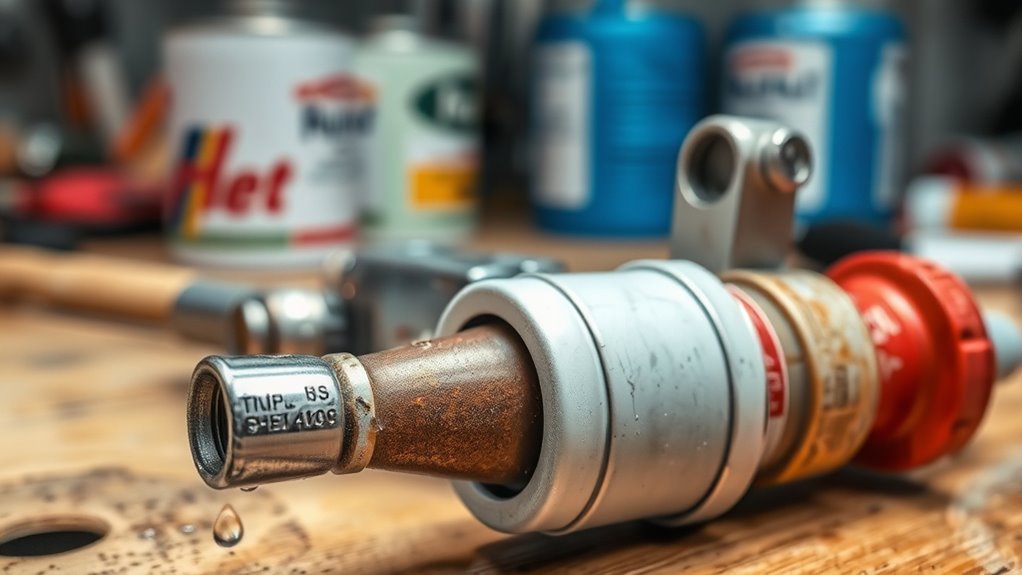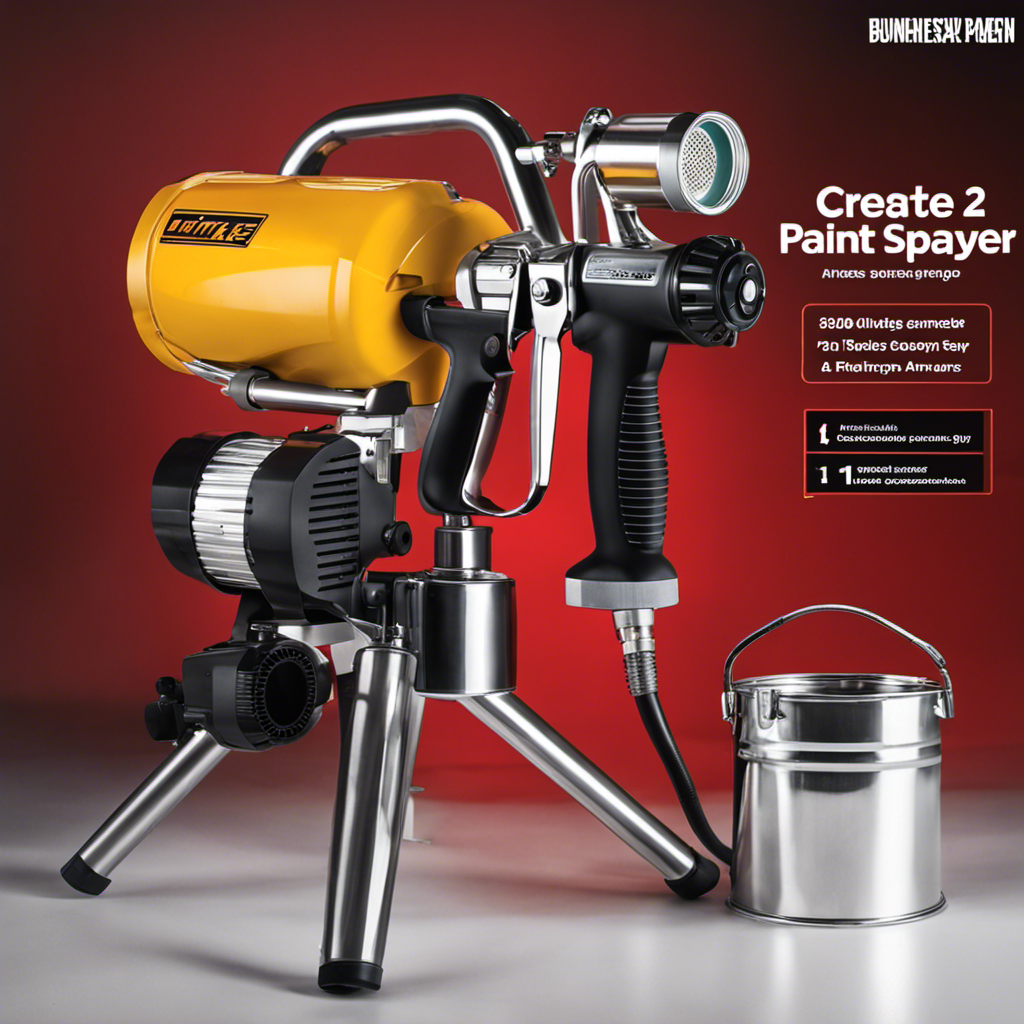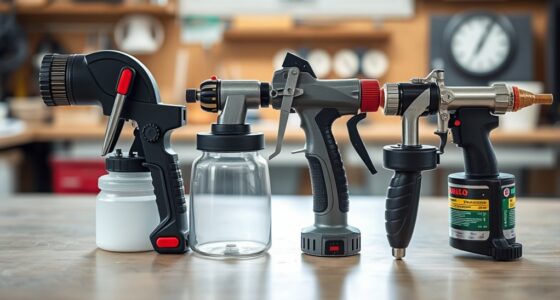You should clean your paint sprayer after each use to keep it functioning properly and prevent clogs. For regular projects, a quick rinse and thorough cleaning after every job is enough, but for heavy or frequent work, consider disassembling and cleaning parts weekly. Monthly deep cleans help spot wear and guarantee peak performance. Staying consistent with your cleaning routine preserves your sprayer’s lifespan and spray quality—keep going to discover how to make maintenance even easier.
Key Takeaways
- Clean your paint sprayer after every use to prevent buildup and ensure optimal performance.
- Perform a thorough cleaning after every project, regardless of size or paint type.
- Disassemble and inspect parts weekly for internal buildup and wear, cleaning as needed.
- Deep clean monthly, including checking for worn parts and lubricating components.
- Increase cleaning frequency with heavy or thick paints to avoid clogs and mechanical issues.

Cleaning your paint sprayer regularly is essential to guarantee peak performance and a quality finish. When you stick to a proper maintenance schedule, you prevent paint buildup, clogs, and mechanical issues that can compromise your results. Establishing a routine helps ensure you don’t forget to clean your sprayer after each use, which is critical for preserving its longevity and functionality. The frequency of cleaning depends on how often you use the sprayer and the type of paint or coating you’re applying. For instance, if you’re working on a large project or using thick, sticky paints, you’ll need to clean it more frequently than with lightweight, water-based paints.
A well-planned maintenance schedule involves cleaning your spray gun thoroughly after every job, even if it’s just a quick rinse. This prevents paint residue from drying and hardening inside the system, making future cleaning easier and faster. For ongoing projects, it’s helpful to break down your cleaning routine into daily, weekly, and monthly tasks. Daily cleaning might involve flushing out the paint chamber and removing any visible buildup. Weekly, you could disassemble parts of the sprayer to inspect and clean internal components more thoroughly, using the right cleaning tools to reach every nook and cranny. Monthly maintenance should include a deep clean, checking for worn parts, and lubrication if necessary.
Having the right cleaning tools makes all the difference. You’ll want a variety of brushes, brushes with soft bristles for delicate parts, and cleaning solutions suitable for the type of paint you’re working with. Rags, spray cleaners, and even compressed air are invaluable for removing stubborn paint from hoses and nozzles. Using quality cleaning tools ensures you do a thorough job without damaging delicate components. Remember, neglecting proper cleaning tools can leave residues that clog the system or cause uneven spray patterns, ultimately affecting your project’s quality. Proper maintenance also extends the lifespan of your paint sprayer, saving you money in the long run.
Frequently Asked Questions
Can I Leave Paint in the Sprayer Overnight?
Leaving paint in your sprayer overnight isn’t recommended. It can cause clogs, make cleanup harder, and damage the equipment. For paint storage, it’s best to clean your sprayer thoroughly after each use to maintain proper sprayer maintenance. If you must leave paint in the sprayer temporarily, make sure to clear it out as soon as possible and store the equipment properly to prevent drying and damage.
What Cleaning Supplies Are Safest for My Sprayer?
Imagine you’re painting a delicate wooden chair; you want to protect the environment too. You should use environmentally friendly cleaning supplies that are compatible with your sprayer’s solvents. For example, biodegradable cleaners work well without damaging components. Always check the manufacturer’s recommendations for solvent compatibility, ensuring you choose safe, effective options that won’t harm your equipment or the environment. Regular cleaning with these supplies keeps your sprayer in top condition.
How Do Cleaning Frequency and Paint Type Relate?
You should adjust your cleaning schedule based on paint compatibility. For water-based paints, clean your sprayer thoroughly after each use to prevent clogs and buildup. For oil-based paints, you might need to clean more frequently, especially if switching colors or types. Regular cleaning ensures your sprayer remains in top condition, reducing downtime and maintaining ideal performance. Always follow manufacturer recommendations for your specific paint type and sprayer.
Should I Clean My Sprayer After Every Use?
Imagine finishing a project as the sun sets, and your paint sprayer sits idle. You should clean your sprayer after every use to guarantee proper equipment maintenance and extend its lifespan. Regular cleaning prevents clogs and paint buildup, making future cleaning easier. Stick to consistent cleaning schedules, especially if switching paint types, to keep your sprayer in top shape and ready for your next creative adventure.
Are There Any Signs Indicating My Sprayer Needs Cleaning?
You’ll know your paint sprayer needs cleaning if you notice paint residue building up or the nozzle clogging. These signs indicate that dried paint is obstructing proper flow, which can affect spray quality. Regularly inspecting the nozzle and checking for uneven spray patterns help you catch issues early. Cleaning your sprayer promptly prevents further clogs and guarantees consistent results, saving you time and effort in the long run.
Conclusion
To keep your paint sprayer singing smoothly, it’s best to give it a gentle touch-up after each use. Think of it as a quick refresh to keep everything flowing effortlessly, preventing any unwanted buildup from sneaking in. Regular cleanings guarantee your tool remains a loyal partner on your creative journey, ready to bring your visions to life without a hitch. A little care now keeps the magic alive for many projects to come.
Franz came aboard the Paint Sprayer Zone team with a background in both journalism and home renovation. His articulate writing style, combined with a passion for DIY projects, makes him an invaluable asset. Franz has a knack for breaking down technical jargon into easy-to-understand content, ensuring that even the most novice of readers can grasp the complexities of paint sprayers.










